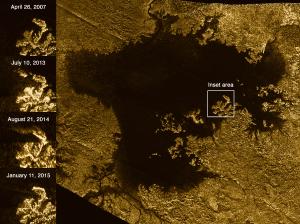Blog
Bubble Tea
9 December 2019
 NASA/JPL-Caltech/ASI/Cornell
NASA/JPL-Caltech/ASI/CornellTitan is a cold and distant world, shrouded in a thick, smoggy atmosphere. While it is very different than Earth, it shares many similar features. It has a complex geology with seas and rivers, rains and seasons. Instead of liquid water, the seas of Titan are liquid hydrocarbons such as methane and ethane. While these liquid hydrocarbons share many similarities with liquid water on Earth, there are also significant differences.
Titan’s thick atmosphere obscures the surface at visible wavelengths, but radar images can penetrate the atmosphere to reveal its surface. When the Cassini spacecraft made several close flybys of Titan, it was able to capture high-resolution radar images of the surface. The features they revealed look similar to the lakes of Northern Canada. But it also captured strange “magic islands” that seemed to appear and disappear over time.
Obviously, islands don’t just disappear. It was likely a surface effect that reflected radar in a way similar to the solid terrain. But there’s been some debate as to its cause. One idea was that it was due to waves on the lake, caused by high winds, or perhaps ice forming on the surface. But another idea is that the magic islands were due to bubbles of nitrogen rising out of the lake.
Recently, simulations of Titan’s environment support the bubble idea. As recently published in Geophysical Research Letters,1 when a mixture of methane, ethane, and nitrogen are held at temperatures and pressures similar to Titan, it can produce rapid bubble formation of nitrogen. It is possible for such bubbles to be formed in lakes due to geologic activity, and they would appear similar to the magic islands observed on Titan.
Large bubble regions could not only fool radar images into seeing “magic islands,” they could also play a critical role in the geology of Titan, shaping the way lakes and rivers form on the icy world.
Farnsworth, Kendra K., et al. “Nitrogen Exsolution and Bubble Formation in Titan’s Lakes.” Geophysical Research Letters (2019). ↩︎